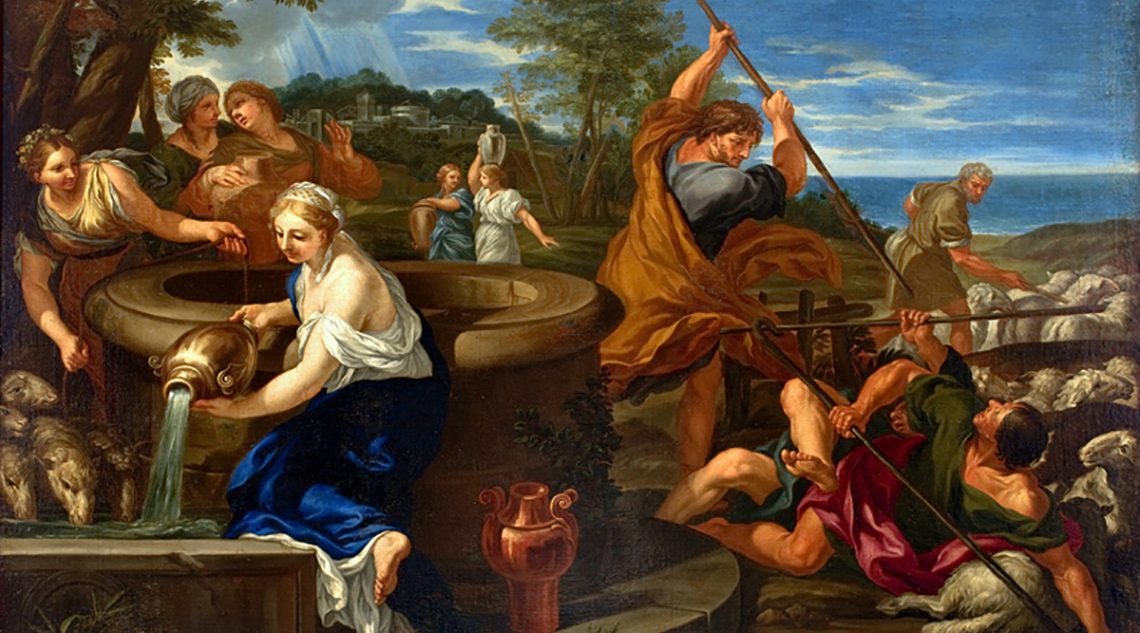Moses, returned to Pharaoh’s household, retained his identity as a Hebrew. For when he saw an Egyptian mistreating a Hebrew, Moses killed the Egyptian and buried him in the sand. When he saw two Hebrews fighting, he admonished them. One of them challenges Moses by inquiring who put him in charge of them, and then asks, “What are you going to do? Kill me like you did the Egyptian?”
Realizing that his crime has become known, Moses flees for his life.
But Moses fled from the face of Pharaoh, and lived in the land of Midian, and he sat down by a well.
This sitting down by a well strikes us as pretty unremarkable, but not so the ancient reader of the books of Genesis and Exodus. For them, this simple statement is the equivalent of watching a man with a gun belt on riding into a town in the old West and tying his horse up at the saloon. Something significant is about to happen. How does the ancient reader know that?
We’ve already talked about two different “type scenes,” or what I call “story frameworks.” So far, we’ve looked at The Barren Woman, and The Rejected Cornerstone. What we have here is the beginning of a Betrothal Narrative. The betrothal narrative goes like this: 1) The protagonist, usually the prospective groom, goes to a foreign land. In this case, Moses has gone to Midian. 2) The prospective groom then goes to a well. Here Moses sits by a well. 3) At this well, the prospective groom meets a girl or girls — keep that in mind. 4) Next, someone offers to draw water, and then does so. 5) The girl or girls them rush back home, telling their father about it. 6) The stranger is then invited to share a meal, after which 7) a betrothal takes place.
By the time we get to Exodus chapter 2, this “type scene” has already played itself out at least twice. First, there was Eliezer, Isaac’s servant, who goes seeking a bride for Isaac. This, as you have noticed, is a variation on the scene, something very common. Instead of the prospective groom Isaac, Eliezer goes as his surrogate. But Eliezer goes to a well where he encounters Rebecca, who draws water for him and his camels. In practical terms, this is a great deal of water! Rebecca then rushes back to her father, telling of Eliezer’s offer. Eliezer is invited to a meal, after which the betrothal is announced.
And then there is the situation with Jacob. Jacob, like Moses, is fleeing for his life to a foreign land. Upon reaching that foreign land he finds shepherds around a well. He says he’s looking for his uncle Laban, and they inform him that Laban’s shepherd is coming soon. Jacob looks up and sees Rachel, whom he immediately loves. Then, in an impressive show of strength, he removes the stone covering on the well so that shepherds can draw water. Rachel rushes back home to tell her father, Laban, who invites Jacob to dinner. Very soon this is followed by a betrothal.
So when Moses, in this foreign land, sits down by a well, the informed reader waits with anticipation. And we are not disappointed.
Now the priest of Midian had seven daughters. They came and drew water, and filled the troughs to water their father’s flock. The shepherds came and drove them away; but Moses stood up and helped them, and watered their flock. When they came to Reuel, their father, he said, “How is it that you have returned so early today?”
They said, “An Egyptian delivered us out of the hand of the shepherds, and moreover he drew water for us, and watered the flock.”
He said to his daughters, “Where is he? Why is it that you have left the man? Call him, that he may eat bread.”
Notice how closely this episode follows the formula of the Betrothal Narrative. The only significant variation here is that instead of one girl, there are seven.
Oh yes, and the final part?
Moses was content to dwell with the man. He gave Moses Zipporah, his daughter.
Compared to the other instances of the Betrothal Narrative, this may seem too simple, too elementary to count. But as Robert Alter points out:
These few verses may seem so spare a treatment of the convention as to be almost nondescript, but in fact this is just the kind of betrothal type-scene needed for Moses. To begin with, any presentation that would give more weight to Zipporah than merely one nubile daughter out of seven would throw the episode off balance, for her independent character and her relationship with Moses will play no significant role in the subsequent narrative.[i]
In other words, the way the author handles this convention, this formulaic narrative, foreshadows the significance of Moses’ wife in the rest of his story. She appears only once later in the story of Moses, and that in a very strange scene. The author hints at that here, by giving her scant mention even in her own Betrothal Narrative.
Like the other type scenes, you want to keep this in the back of your mind. We will encounter it again, more than once.
Read other posts in the “Matriarchs and Prophets” series.
—
[i] Alter, Robert (2011-04-26). The Art of Biblical Narrative (p. 68). Basic Books. Kindle Edition.










